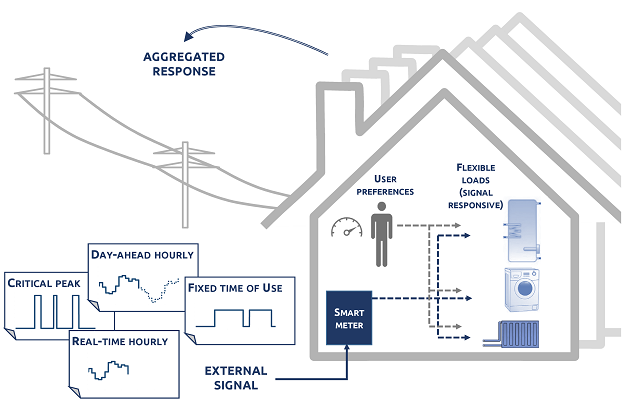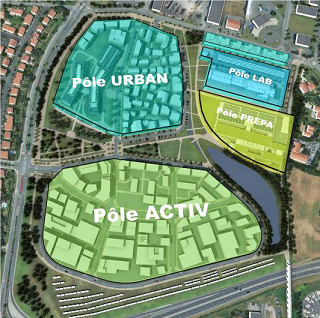ANR CLEF > 2018-2021 CLEF [ANR]
Financement : Agence Nationale de la Recherche, Défi 6 (Transports et systèmes urbains durables), AAP Jeunes Chercheuses/Jeunes Chercheurs (ANR-17-CE22-0005-01)
Partenaires : LaSIE (coordination), G2Elab, Atlantech
Participants LaSIE :
Résumé :
Energy flexible buildings can support the integration of renewable energy sources in the national energy mix by modulating their energy use. Modulating the heating energy use of new and existing buildings could provide 10 to 20 GW of flexible load in France according to the literature and demonstrator projects. Despite a large potential identified, a number of issues prevents the deployment of this technology : communication, privacy, cost-effectiveness, control and reliability of the response.
This project focusses on the last two issues and will test indirect control strategies to maximise the flexibility potential and coordinate the response of energy flexible buildings. The advantages of indirect over direct control strategies are the ease of deployment and the respect of the users’ privacy. The use of an indirect controller will ensure that the objective of matching production and demand is achieved at the aggregated level, though allowing some degrees of freedom at the building scale (the signal sent can be interpreted differently by each end-user’s energy management system). However, the main challenge of indirect controller is to get a reliable estimation of the capacity available, in order to be able to trade the capacity on the electricity market. This lack of reliability in the response has been identified as a barrier to the development of indirect control strategies for demand response. In this project, indirect control strategies combined with a rule-based controller (RBC) at the building level will be simulated on different case studies, accounting for the diversity of buildings and users. This project is centred on the building energy use, but will consider the problem from a district perspective using an integrated and multidisciplinary modelling approach, in order to come up with robust and optimised solutions.

The project is coordinated by LaSIE (La Rochelle), and partners from G2Elab (Grenoble) will bring their expertise in the modelling of electrical networks. The project is divided in three main parts : the first part is related to the development of the simulation platform, the second part to the evaluation of the control strategy on the Atlantech low carbon district, and the last part to the robustness and of the reliability of the controller developed. In the first part, the building models will be defined using building energy simulation tools and grey-box models will be developed to ensure a short computation time. The building typology of the Atlantech low carbon district will be used as a reference and different types of users (based on stochastic modelling) will be considered. In parallel, the LV electrical network and the local production systems will be developed. Steady-state and simple modelling techniques will be used to focus on the main problems that can arise from energy flexible buildings (e.g. peak demand, ramping, voltage stability). The last step of the platform development will be to validate the integrated model using measured data from the Atlantech district in La Rochelle. Based on this integrated model developed, indirect control strategies combined with RBC will be tested and analysed on the case-study to properly evaluate the performance at the grid and building levels. The objective of this part is to check that the proposed control strategy makes use of the flexibility potential and does not create any side-effects. Finally, the last part will focus on the reliability of the control proposed and will extend the work to more case-studies. The sensitivity of the controller will then be evaluated, by varying the response of the users, the types of building and the environment.
The results of the project can be used to define control strategies that enable demand response for residential customers and also to provide tools for a reliable estimation of the shifting capacity under indirect control.

Publications liées :
M. Vellei, S. Martinez and J. Le Dréau, 2021. "Agent-based stochastic model of thermostat adjustments : A demand response application", vol 238, in Energy and Buildings.
M. Vellei, J. Le Dréau and Y. Abdelouadoud, 2020. "Predicting the demand flexibility of wet appliances at national level : the case of France", vol 214, in Energy and Buildings
M. Vellei and J. Le Dréau, 2019. “A novel model for evaluating dynamic thermal comfort under demand response events”, vol 160, in Building & Environment.
J. Le Dréau, M. Vellei and S. Martinez, 2020 "On the influence of occupants on the energy flexibility of buildings : a sensitivity study at district scale", in BSO 2020, UK.
M. Vellei and J. Le Dréau, 2020, "On the prediction of dynamic thermal comfort under uniform environments", Windsor 2020, UK.
J. Le Dréau, M. Vellei and Y. Abdelouadoud, 2019. “A Bottom-Up Model to Evaluate the Flexibility of French Residential Wet Appliances”, in Building Simulation 2019, Italy.
M. Vellei and J. Le Dréau, 2019. “Evaluating Dynamic Thermal Comfort under Demand Response Events : a Novel Model Compared against Fanger’s PPD Model”, in Building Simulation 2019, Italy.
J. Le Dréau, I. Mellas, M. Vellei and J. Meulemans, 2019. “Upscaling the flexibility potential of space heating in single-family houses”, in CISBAT 2019, Switzerland.
Page Research Gate : Lien

